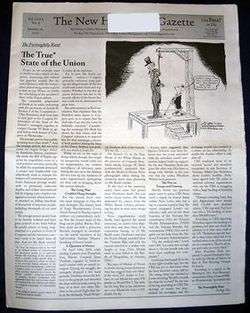The New Hampshire Gazette
|
January 26, 2007 (subscription edition) of The New Hampshire Gazette | |
| Type | Bi-Weekly newspaper |
|---|---|
| Format | Small format broadsheet |
| Publisher | Steven Fowle, Editor in Chief |
| Founded | 1756/1989 |
| Headquarters | Portsmouth, New Hampshire |
| Website | nhgazette.com |
The New Hampshire Gazette is a non-profit, alternative, bi-weekly newspaper published in Portsmouth, New Hampshire. Its editors claim that the paper, published on-and-off in one form or another since 1756, is the oldest newspaper in the United States and has trademarked the phrase "The Nation's Oldest Newspaper."
History
The New Hampshire Gazette was founded in Portsmouth October 7, 1756, by printer Daniel Fowle as the first newspaper in the Province of New Hampshire. Fowle lived in Boston before founding the Gazette, and was the first to print the words of Samuel Adams. He also spent time in prison for printing anti-British pamphlets "The Monster of Monsters" and "A Total Eclipse of Liberty."
The Gazette continued publishing after Fowle's death in 1787, and in 1839, was recognized as the oldest newspaper in America after the Maryland Gazette ceased publication. Starting in the 1890s, the Gazette was published by The Portsmouth Herald on weekends as a supplement to the Herald. In 1960, the Gazette was renamed the Herald Weekend Edition, although the masthead indicated that the paper was "Continuing the New Hampshire Gazette."
In 1989, a descendant of Daniel Fowle's, Steven Fowle, discovered that the Herald relinquished the trade name for the Gazette. Fowle registered the rights to the name and that spring began publishing the Gazette as an independent entity "episodically, in a very small format" until May 1, 1999, when the publishers began its current format and schedule.
Claims of seniority
The Hartford Courant, founded as a weekly in 1764 , calls itself the nation's oldest continuously published newspaper, and is cited as such in standard journalism history texts. It was an independent company until being absorbed by the Times Mirror chain around 1980, then Tribune Corporation acquired Times-Mirror. In contrast, the New Hampshire Gazette has changed owners "over two-dozen times," by its owner's count, and has sometimes been merged with other publications.
The Newport Mercury in Rhode Island was identified as the nation's oldest newspaper during one of the New Hampshire Gazette's lulls. It was founded in 1758 . The Mercury eventually was published by The Newport Daily News as a weekly by-mail edition, reprinting stories from the daily for out-of-town subscribers. Most recently, it became a tabloid magazine and Web site using the addess newportmercury.com but also using the name Mercury Magazine.
Content and format
The Gazette, as an alternative paper, is more focused on commentary than the reporting current events. Its editorial content can easily be described as "liberal". In recent years the paper has cemented its self-imposed mission as an independent voice railing against corporate media and conservative political control.
Published every two weeks as a smaller format broadsheet, usually of 14–20 pages, the Gazette's front page is usually an editorial called the "The Fortnightly rant" covering a few subjects of national or regional importance, accompanied by a political cartoon by Mike Dater reflecting the editorial. The motto of the newspaper is the motto of the state of New Hampshire, Live free or die.
Among articles of varying size and content are regular columns such as "Moving Pictures" (film commentary) by Rodman Philbrick and most notedly a regular essay, "History Matters," covering two pages or more by Portsmouth historian J. Dennis Robinson. Other regular features include "Hate Mail, Mash Notes, & Other Correspondence" (the letters page), the "Northcountry chronicle", an editorial by William Marvel, "Free The Media Press" (stories culled from the New Hampshire Indymedia Collective), and a reprinting of "Vintage News" from past issues of the Gazette usually dating to the mid-19th century, ("Better old news, than new lies."). The most popular section of the newspaper is "Admiral Fowle's Piscataqua River Tidal Guide" on the last page which, in addition to a chronology of the tides to take place over each day of the upcoming two weeks, contains an idiosyncratic, and often hilarious listing of significant events from that day in history.
Circulation
The paper's circulation, at over 5,500 readers, is relatively small, but as it is a non-profit independent paper with no marketing, it can be considered a significant number. Its readership is also very loyal, with nearly 1,000 mail subscribers throughout the country.
Website
For many years, the website for the Gazette had many resources in relation to its history, including a 19th-century reproduction of its first issue, a timeline and explanation of its position as oldest newspaper, and much more. Beginning the summer of 2007, the website changed focus and format to that of blog-type website. Content from each issue of the paper is minimal in comparison with how most newspapers publish articles online as well as in print, though the Gazette occasionally does offer a .pdf of an issue, usually a couple of weeks after its publication.
References
External links
- The New Hampshire Gazette online
- The Gazette at MySpace
- A 1998 interview with Steven Fowle
- University of New Hampshire history of early New Hampshire media beginning with the Gazette
